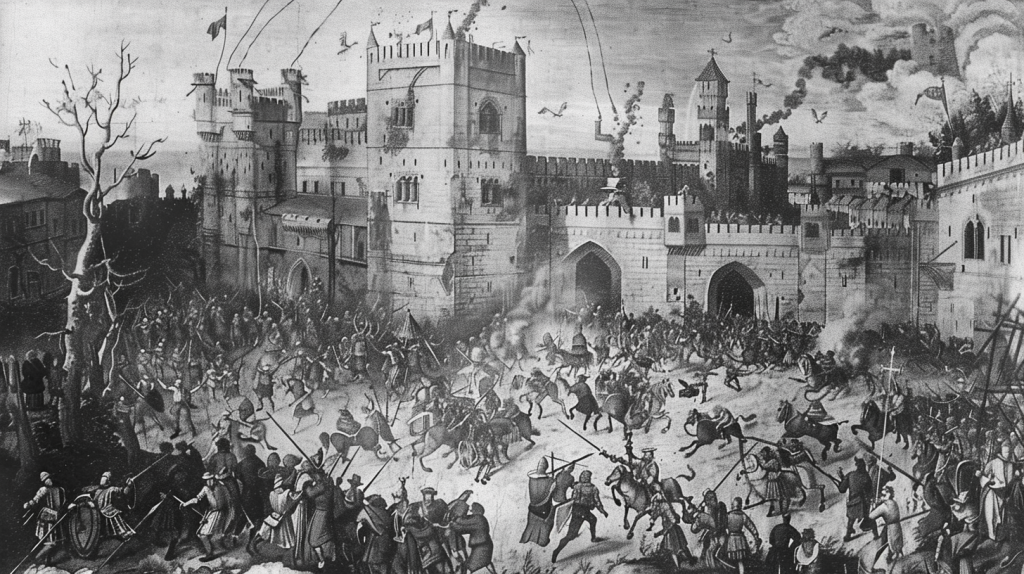In the bustling streets of Tudor London, tensions were brewing. The year was 1517, and the city was about to witness one of the most infamous outbursts of xenophobia in its history. The Evil May Day riot, also known as Ill May Day, erupted as a violent protest against foreigners living in the English capital.
This event would leave an indelible mark on London’s social fabric and serve as a stark reminder of the destructive power of fear and prejudice. The story of Evil May Day provides a fascinating glimpse into the complex dynamics of urban life in 16th-century England, revealing how economic anxieties and cultural differences can sometimes lead to devastating consequences.
You’ll also, sadly, notice many of the issues here we still see today.

The Seeds of Discontent
To understand the roots of the Evil May Day riot, we must first examine the social and economic landscape of London in the early 16th century. The city was experiencing rapid growth and change, attracting merchants, craftsmen, and laborers from across Europe. Many of these newcomers, referred to as “strangers” by the local population, brought valuable skills and contributed to the city’s thriving economy.
However, this influx of foreign workers also sparked resentment among some native Londoners. They feared job competition and blamed the newcomers for rising living costs and housing shortages. These economic anxieties, combined with cultural differences and language barriers, created a volatile atmosphere ripe for conflict.
Sound familiar to our modern society?!?
The Spark That Ignited the Flame
As spring approached in 1517, rumors began to circulate that foreigners were planning to seize control of the city and murder English residents. These baseless claims, fueled by xenophobic sentiment, spread like wildfire through London’s taverns and marketplaces.
On April 30th, a preacher named Dr. Bell delivered a sermon at St. Paul’s Cross, warning of the supposed dangers posed by foreigners. His inflammatory words resonated with many disgruntled Londoners, setting the stage for the violence that would unfold the following day.
The Night of Chaos
In the early hours of May 1st, 1517, a mob of angry apprentices and laborers took to the streets. Their initial target was Newgate Prison, where they freed several inmates who had been arrested for attacking foreigners. Emboldened by their growing numbers, the rioters then turned their fury on the homes and businesses of London’s immigrant population.
A City Under Siege
The violence quickly spread across London, with rioters looting and destroying property belonging to foreigners. Homes were ransacked, shops were pillaged, and many innocent people found themselves caught in the crossfire. The chaos continued throughout the night, with the city’s authorities struggling to regain control.
The Role of John Lincolne
One of the key figures in the Evil May Day riot was John Lincolne, a broker who had been actively stirring up anti-foreign sentiment in the weeks leading up to the event. Lincolne was among those who encouraged the mob to target specific areas known for their high concentration of foreign residents.
Again, this story is chillingly familiar and relatable in our modern world. It seems like we really haven’t moved on too much in the last 500 years.
The Response of the Authorities
As dawn broke on May 2nd, the full extent of the damage became apparent. The city’s leaders, including the Lord Mayor of London and the Duke of Norfolk, finally managed to quell the riot. Hundreds of participants were arrested, and the search for the ringleaders began in earnest.
King Henry VIII’s Intervention
News of the riot quickly reached King Henry VIII, who was then residing at Greenwich Palace. Enraged by the attack on foreign merchants, many of whom were under his protection, the king ordered swift and severe punishment for those responsible. Good old Henry did love to dole out severe punishment, even with minimal proof.
The Trials and Executions
In the days that followed, dozens of rioters were put on trial. Many were found guilty and sentenced to death. John Lincolne, identified as one of the main instigators, was among the first to be executed. However, as the trials progressed, there was growing concern about the scale of the planned executions.
The Aftermath and Pardons
Realizing that executing hundreds of Londoners could lead to further unrest, King Henry VIII decided to show clemency. In a dramatic public ceremony at Westminster Hall, the king pardoned the majority of the rioters. This act of mercy was carefully staged to demonstrate both the king’s power and his benevolence.
Was he tyrannical? Undoubtedly. But was he also incredibly smart and shrewd? A billion percent yes! As were the king’s most trusted advisors.
Long-Term Consequences
While the immediate crisis had been resolved, the Evil May Day riot left a lasting impact on London’s social fabric. Tensions between native Londoners and foreign residents remained high for years to come. The event also led to increased scrutiny of immigrant communities and stricter regulations on foreign workers in the city.
Lessons from Evil May Day
The Evil May Day riot of 1517 serves as a sobering reminder of how quickly fear and prejudice can escalate into violence. It highlights the importance of addressing economic anxieties and promoting cultural understanding to prevent such outbursts of xenophobia.
Echoes in Modern Times
Sadly, the themes underlying the Evil May Day riot continue to resonate in today’s world. Issues of immigration, economic inequality, and cultural integration remain contentious topics in many societies. By studying events like Evil May Day, we can gain valuable insights into the complex dynamics that shape our communities and work towards building more inclusive and harmonious societies.
